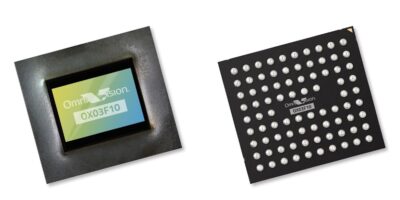OmniVision increases image sensors and adds cybersecurity
Digital imaging specialist, OmniVision Technologies, has added the OX03F10 automotive image sensor to its family for automotive viewing cameras.
The ASIL-C sensor maintains simultaneous 140dB HDR and LED flicker mitigation, and offers increased resolution and cybersecurity to support vehicle designers transition from Level 2 and Level 3 advanced driver assistance systems (ADAS) to higher levels of autonomy.
The OX03F10 maintains the combination of a large 3.0M pixel size with a high dynamic range (HDR) of 140dB featured in the company’s other automotive image sensors in the series. It is also claimed to have the best LED flicker mitigation (LFM) performance for minimised motion artefacts. The sensor is offered in a 1/2.44-inch optical format and features a four-lane MIPI CSI-2 interface.
It is also believed to be the first viewing image sensor with HDR and LFM that can deliver the wide vertical array resolution of 1920 x 1536p at the highest rate of 60 frames per second. This provides the high image quality needed when feeding surround view system (SVS) captures into autonomous, machine vision systems, explains OmniVision. The OX03F10’s wider vertical array is also important in e-mirror applications, for wider coverage and blind-spot elimination.
“In addition to excellent image quality across all lighting conditions, higher resolution and cybersecurity are becoming must haves for the designers of viewing cameras—particularly for SVS,” said Kavitha Ramane, staff automotive product marketing manager at OmniVision. The OX03F10 operates over the entire automotive temperature range and has ASIL-C functional safety.
The 3Mpixel resolution and cybersecurity features are required to integrate viewing cameras into autonomous vehicle systems. Cybersecurity ensures the images supplied to autonomous systems have not been altered, and augmented reality (AR) can take advantage of the OX03F10’s capabilities, for use within the vehicle, including in infotainment systems.
The OX03F10 also maintains the industry’s smallest package size, says OmniVision, and low power consumption, so that cameras that continuously run at 60 frames per second, can be positioned even in the tightest spaces. The image sensor also retains the family’s basic image processing capabilities, including defect pixel correction and lens correction. The integrated HDR and LFM engine (HALE) algorithm is the only imaging technology that can simultaneously provide top HDR and LFM performance, claims OmniVision. The result is high image quality for automotive viewing applications, including SVS, rear view cameras (RVC) and e-mirror camera monitoring systems (CMS), across all lighting conditions and in the presence of flickering LEDs from headlights, road signs and traffic signals.
OmniVision’s Deep Well, dual conversion gain technology enables the OX03F10 to capture significantly lower motion artefacts than competing sensors offering 140dB HDR. The split-pixel LFM technology with four captures offers the best performance over the entire automotive temperature range, claims OmniVision.
The viewing camera image sensors have OmniVision’s PureCel Plus-S stacked architecture, which provides pixel performance advantages over non-stacked technology. For example, explains the company, 3D stacking allows a boost to pixel and dark current performance, for a “significant performance improvement” over the prior generation of OmniVision’s viewing camera sensors.
This OX03F10 image sensor is available now for limited sampling in a-CSP and a-BGA packages, and is planned to be AEC-Q100 Grade 2-certified.




